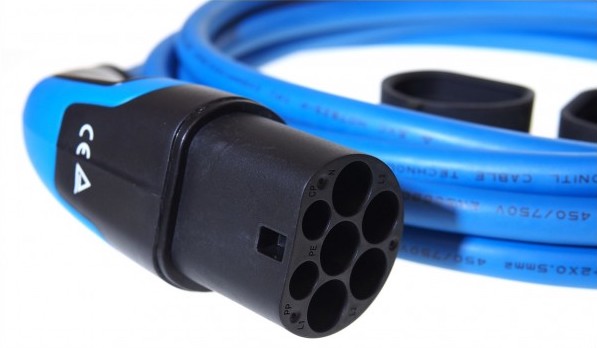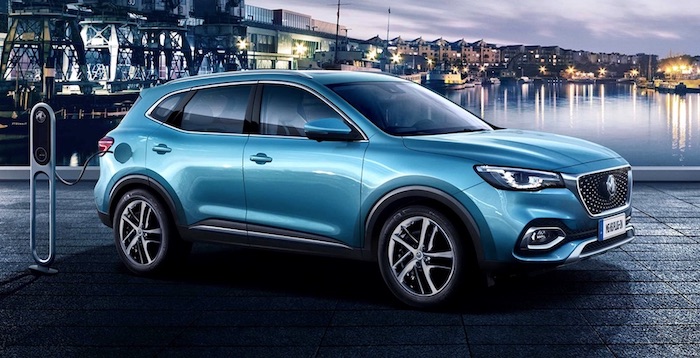Electric Cars: The Basics
For those of you new to zero-emission electric driving, we recommend a read of the following articles:
Sign up to the e-zoomed Electric Living newsletter
What Is A Tethered Home EV Charging Point?
Put simply, in a tethered home EV charging station, the EV cable that is used to charge the electric vehicle (EV) is permanently fixed (attached) to the EV charging station. The length of the attached cable varies depending on the manufacturer, but most manufacturers offer a length between 4m and 8m. As an example, the myenergi tethered zappi EV charger has a 6.5m cable attached to the electric car charger.
In general, tethered electric car charging points are popular with residential customers in the UK. Tethered electric car charging stations come with either a Type 1 or a Type 2 EV cable. One of the arguments so far for choosing an untethered (socket only- cable not attached) EV charging station, is the flexibility for charging EVs that require either a Type 1 or Type 2 EV cable.
However, most of the newest battery-electric vehicles (BEVs) and plug-in hybrid electric vehicles (PHEVs) require a Type 2 EV cable, therefore mitigating to a large extent the need for a Type 1 charging station. An example of an EV that requires a Type 1 cable is the older generation of the pure-electric Nissan Leaf. However, the latest Nissan Leaf use a Type 2 EV cable. As the electric vehicle industry continues to mature, we can expect a continued focus on type 2 charging standard.
The advantages of a tethered charging station are convenience and safety. In a tethered unit, the EV cable can be safely stored back into the unit after operation, reducing the risk of anyone tripping over an EV cable left on the ground.
Moreover, with an attached cable, an EV owner simply has to come home and plug-in the charging cable, making it fast and convenient to commence EV charging. In the case of an untethered charging cable, the EV owner needs to remove the EV cable from the boot etc., which is not as convenient as a tethered charging station, in particular on cold days or after a long work day.
For some households, that only charge their electric car at home, buying a tethered EV charging station reduces the need for buying an additional EV cable (i.e. no need for a spare EV cable in the boot for public charging). In any case, we recommend inculcating a habit of neatly folding the tethered EV cable after the charging session. It is better for the long-term maintenance of the EV cable and EV charging station.

What Is An Untethered Home EV Charging Station?
In an untethered electric car home charging unit, the EV charging cable that is used to charge your EV is not permanently fixed to the charging station. Such an EV home charging station is usually referred to as ‘socket only’. An untethered home EV charging point is popular with those families that may need to have the flexibility to charge both a Type 1 and Type 2 electric car.
With a socket only charging station a user can use either a Type 1 or Type 2 EV charging cable. A socket only EV charger does not come with an EV cable, which needs to be purchased separately. One of the advantages of the socket only EV charger, is that the same EV cable can be used for home and public EV charging. Of course, if the EV cable is too long to carry, another shorter EV cable will be required for public charging.
The other advantage is that you can use an EV cable of any length and not restricted to just the manufacturers specifications. In some homes, the EV charge point is located much further from the location of the electric vehicle (EV). At e-zoomed we sell EV charging cables up to 50m and it is not uncommon for residential customers to purchase even longer EV cables from us. These customers usually have specific parking limitations that does not allow the EV to be parked close to the EV charger.

What Is Length Of A Cable In A Tethered Charging Unit?
As mentioned above, there is no one length. It varies depending on the manufacturer and charging unit model. For example, an EVBOX Elvi charging point comes with either a 4 m or 8 m cable, depending on which specific Elvi model you choose. We at e-zoomed recommend choosing an electric car charging station that has at least a 5m tethered cable. It is far more practical for the long-term! We also recommend measuring the distance from the EV charger to the electric car carefully, so that you are certain the tethered EV cable can reach the EV easily.
What Is The Ideal Length Of A Cable In A Untethered Charging Unit?
There is no one length. It varies depending on your requirements but usually sold at lengths between 5 m and 50 m. Of course, also carefully consider storage when deciding on a cable. Ideally, the EV cable is stored in a cool and dry place indoors. We at e-zoomed sell electric car charging cables (type 1 and type 2) in various lengths, from 2m up to 50m! We also offer bespoke lengths of any size. To enquire please email us at shop@ezoomed.com.

Which Is Better: A Tethered Or Untethered Electric Car Charging Station?
In general, most EV drivers carry an EV cable in their electric car boot to enable public EV charging when on the road. However, the majority of time, an electric car is charged at home and usually overnight when the tariff rates are cheaper. We always recommend using green energy to power your home and plug-in electric car. This way the ‘well-to-wheel’ emissions are zero.
By owning a tethered home EV charging station, the EV owner is not inconvenienced by removing the cable from the boot every time the green car needs charging. Practically the best option, given the weather in the UK and avoids the hassle of uncoiling and coiling an untethered cable. On the flip side, the length of the tethered cable is fixed and can sometimes have limitations for home charging if you need to change where you park or the type of electric vehicle to be charged.
Tethered cables can be stowed away in a tidy and easy manner which avoids any potential for tripping or injury when left running across the driveway. There is also the added comfort of security i.e. the cable cannot be removed or stolen from the charging station. Replacing a cable can be expensive and in most cases costing over £200, if not much more.
The advantage of untethered cables is that the EV driver is not restricted to a particular connector type, specially if the household has more than one electric car and different connectors are required or the household is looking to buy EV’s in the future that may need other connector types. However, if the family only owns one EV, then a tethered unit will do just fine. With untethered you are not limited to the length of the cable i.e. much more flexibility.
In conclusion, there is no straightforward answer. It depends on the circumstances, the type of EV you own, your budget, aesthetics, future proofing and your personal choice.
While e-zoomed uses reasonable efforts to provide accurate and up-to-date information, some of the information provided is gathered from third parties and has not been independently verified by e-zoomed. While the information from the third party sources is believed to be reliable, no warranty, express or implied, is made by e-zoomed regarding the accuracy, adequacy, completeness, legality, reliability or usefulness of any information. This disclaimer applies to both isolated and aggregate uses of this information.





































